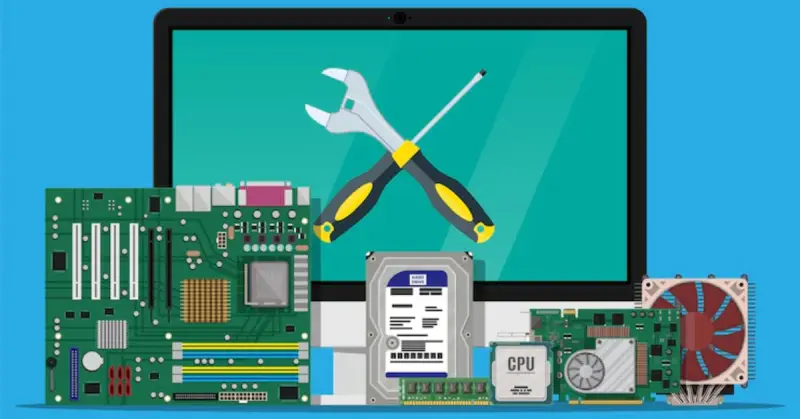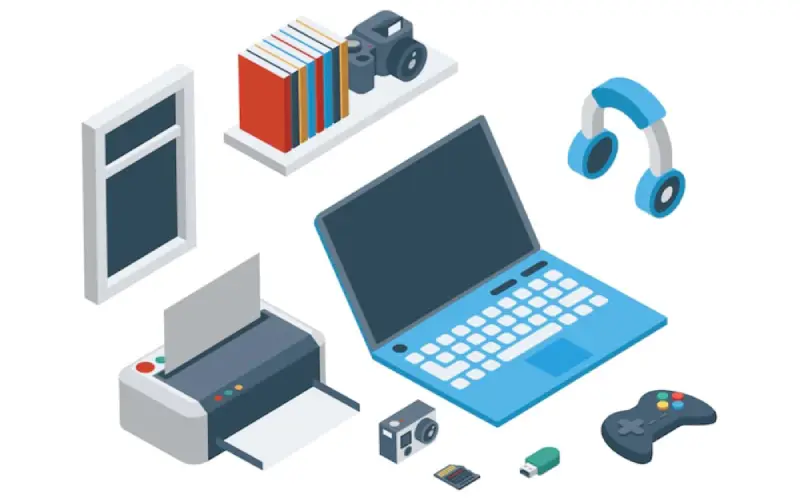Hi there! This is a guide that will teach you the basics of computer hardware parts. You’ll learn what they are and what they do. This guide is for anyone who likes computers or wants to learn more about categories of computer hardware.
In this guide, we’ll talk about the main parts of a computer. We’ll start with the CPU, which is like the brain of the computer. Then we’ll move on to memory, storage, motherboards, GPUs, and input devices. We’ll explain all categories of computer hardware in simple words and tell you why they’re important.
List of Computer Hardware
- Central Processing Unit (CPU)
- Memory
- Storage Devices
- Motherboard
- Graphics Processing Unit (GPU)
- Input Devices

Central Processing Unit (CPU)
The CPU is like the brain of the computer, handling instructions and calculations. It comes in different models and speeds that affect overall performance. Inside the CPU, you’ll find the arithmetic logic unit (ALU) for math operations, the control unit managing data flow, and cache memory for quick access.
Memory (Ram)
Memory is essential for storing and retrieving data and instructions. There are two main types: Random Access Memory (RAM) and Read-Only Memory (ROM). RAM is temporary storage for quick CPU access. ROM holds vital system instructions, even when the computer is off.
Storage Devices (SSD & HDD)
When it comes to keeping your data safe and sound for the long haul, storage devices are the real MVPs. We have two heavyweights in the ring: hard disk drives (HDDs) and solid-state drives (SSD). HDDs work their magic by storing data on spinning disks, while SSD takes a different approach, using flash memory to make things snappier and last longer. It’s like having a DJ spinning records versus a speed demon zipping through a racetrack. Either way, these storage champs have got your back when it comes to keeping your files safe and accessible.
Motherboard
The motherboard is like the central hub that connects and holds all the hardware components together. It provides electrical pathways for data transfer and enables communication between devices. The motherboard houses the CPU, memory modules, storage devices, and expansion cards like graphics cards and network adapters.
Graphics Processing Unit (GPU)
The GPU is a specialized component for complex calculations and graphics rendering. While CPUs can handle graphics, GPUs excel in parallel processing, perfect for rendering images, videos, and 3D graphics. Gamers, graphic designers, and high-performance tasks rely on GPUs.
Input Devices
Input devices let you interact with the computer. Common ones include keyboards, mice, touchscreens, and scanners. Keyboards allow text input and commands, mice control the cursor, touchscreens offer intuitive finger or stylus input, and scanners convert physical documents and images into digital formats.
Additional Hardware Products Which Can be Used in Computer Hardware Devices

1. Central Processing Unit (CPU)
CPU Cooler: A CPU cooler is a device used to dissipate heat generated by the CPU. It consists of a heatsink and a fan or liquid cooling system to keep the CPU temperature within safe limits.
2. Memory
L1, L2, L3 Cache: Cache memory is a small, high-speed memory located closer to the CPU. It stores frequently accessed data and instructions to expedite their retrieval, improving overall system performance.
3. Storage Devices
Solid-State Drives (SSDs): They use flash memory to store your data, giving you crazy fast access, less power drain, and rock-solid reliability. Way better than those old-school HDDs. If you want speed, efficiency, and a storage buddy you can count on, SSDs are the bomb.
External Hard Drives:
External HDDs: External hard drives are portable storage devices connected to the computer via USB or Thunderbolt ports. They offer additional storage space for backing up data, expanding storage capacity, or transferring files.
Network Attached Storage (NAS)
NAS: Network-attached storage devices are dedicated storage systems connected to a network. They provide centralized file storage and sharing capabilities, allowing multiple users to access data simultaneously.
4. Motherboard
- Graphics Card (GPU): A graphics card, also known as a video card or GPU, is an expansion card that handles the rendering of graphics, images, and videos. It offloads the graphics processing tasks from the CPU, enhancing visual performance in gaming, video editing, and graphics-intensive applications.
- Sound Card: Sound Card: A sound card is an expansion card that provides audio capabilities to a computer system. It processes audio signals, allowing users to listen to music, play games with sound effects, and enable audio recording and editing.
5. Graphics Processing Unit (GPU)
eGPU: An external graphics processing unit is a separate GPU enclosure that connects to a computer via Thunderbolt or USB-C ports. It enhances the graphics performance of laptops or desktops by providing additional graphics processing power.
6. Input Devices
- Gaming Controllers: Gamepad/Joystick: Gaming controllers such as gamepads or joysticks are input devices specifically designed for gaming. They offer precise control and tactile feedback for an immersive gaming experience.
- Graphics Tablets: Graphics Tablet: Graphics tablets consist of a pressure-sensitive surface and a stylus. They are commonly used by digital artists and designers to create digital drawings or illustrations with greater precision and control.
- Voice Recognition Devices: These devices, such as microphones or voice-controlled assistants, enable users to interact with their computers through voice commands, allowing for hands-free operation and voice dictation.
By exploring these additional hardware products, you can further enhance your computer system’s capabilities and tailor it to meet your specific needs, whether it’s improved cooling, storage expansion, audio enhancements, or specialized input for gaming or creative work.
Conclusion
knowing about computer hardware categories is super important if you want to rock the tech world. In this awesome guide, we covered everything from the brainy CPU to memory, storage devices, motherboards, GPUs, and input devices. Each category does its own special thing to make your computer work like a charm. When you have the lowdown on computer hardware, you’ll be a pro at making smart choices when buying, upgrading, or fixing your computer. So go ahead, take charge, and conquer the tech world with your newfound knowledge.

